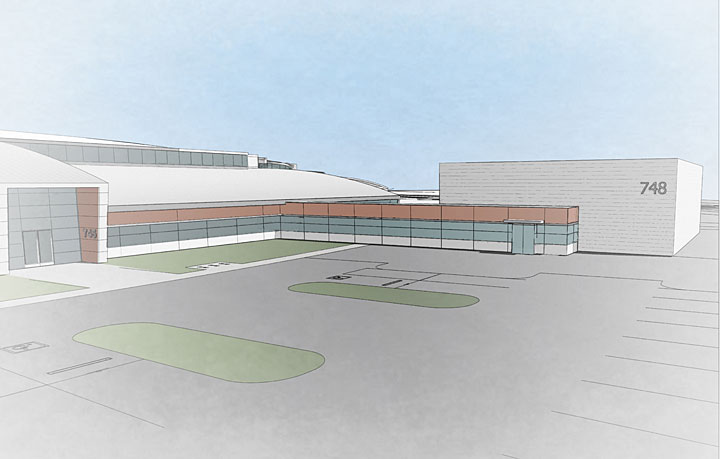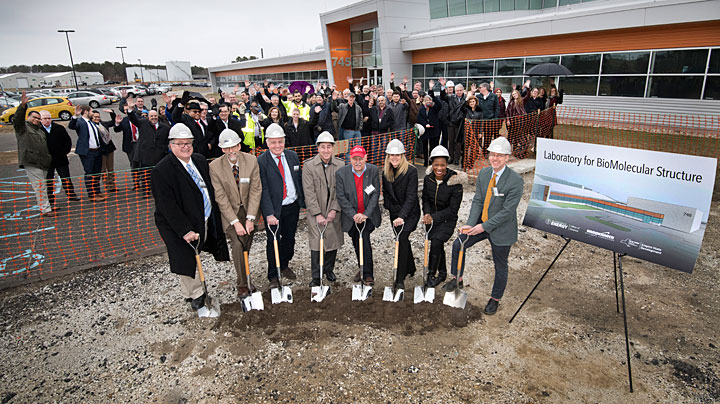Construction Starts on New Cryo-EM Center at Brookhaven Lab
Called the Laboratory of BioMolecular Structure, the new cryo-electron microscope center will offer world-leading imaging capabilities for life sciences research
December 13, 2018
 enlarge
enlarge
An artist's rendering of the Laboratory of BioMolecular Structure extension building (right) at the National Synchrotron Light Source II.
UPTON, NY—Today, the U.S. Department of Energy’s (DOE) Brookhaven National Laboratory broke ground on the Laboratory of BioMolecular Structure (LBMS), a state-of-the-art research center for life science imaging. At the heart of the center will be two new NY-State-funded cryo-electron microscopes (cryo-EM) specialized for studying biomaterials, such as complex protein structures.
“Cryo-electron microscopy is a rapidly-advancing imaging technique that is posting impressive results on a weekly basis,” said LBMS Director Sean McSweeney. “The mission of LBMS is to advance the scientific understanding of key biological processes and fundamental molecular structures.”
“Throughout my career, I have worked hard to make our region of the State a high-tech hub, bringing together the talents and expertise of scientists and facilities across Long Island. I am pleased to have played a part in the creation of the new cryo-EM center, which will add to the incredible facilities at Brookhaven National Lab and enable our scientific community to lead the way in world-class imaging research and discovery,” said NY State Senator Ken LaValle.
Breaking technical barriers in biology
Modern developments in biology, medicine, and biotechnology have been made possible by research tools that visualize biological structures at the atomic level, which is crucial for understanding their function, as well as the role they play in disease.
 enlarge
enlarge
New York State Senator Ken LaValle joined leaders of Empire State Development and Brookhaven Lab for the LBMS groundbreaking ceremony. Pictured from left to right are Jim Misewich (Associate Laboratory Director for Energy and Photon Sciences, Brookhaven Lab), Erik Johnson (NSLS-II Deputy for Construction), Sean McSweeney (LBMS Director and NSLS-II Structural Biology Program Manager), Robert Gordon (DOE-Brookhaven Site Office Manager), Ken LaValle, Cara Longworth (Regional Director, Empire State Development), Danah Alexander (Senior Project Manager, Empire State Development), and John Hill (NSLS-II Director).
Determining these structures has led to numerous breakthroughs in scientists’ understanding of biological processes and can lead to important insights as to what happens when these processes go wrong. As a result, such understanding often leads to discovery of new drugs for treating disease. One technique that can produce such structures with atomic resolution is x-ray diffraction, but it requires that the molecules first be crystallized. This is often a time-consuming and sometimes impossible task. As a result, many important families of biological molecules remain poorly understood.
Cryo-electron microscopy solves these challenges because the technique works on individual molecules and therefore does not require crystallization. In a cryo-EM, samples are maintained at minus 274 degrees Fahrenheit using liquid nitrogen, and then individual molecules are “photographed” by an electron microscope. This capability has enabled scientists to study many new molecules with atomic resolution for the first time.
The two new cryo-EMs at LBMS will enable scientists to resolve complex molecular structures with unprecedented detail. Access to the facility’s tools will be granted through peer review proposals and without charge to successful applicants.
Creating a hub of advanced imaging capabilities
Scientists at LBMS will also benefit from the center’s close proximity to the National Synchrotron Light Source II (NSLS-II), one of the world’s most advanced synchrotron light sources. NSLS-II is a DOE Office of Science User Facility at Brookhaven Lab that creates some of the brightest x-rays in the world. The ultrabright light at NSLS-II can be used by scientists at LBMS for complementary studies, such as protein crystallography, to yield more comprehensive views of their samples’ structures.
“The combination of the advanced research tools at NSLS-II and LBMS will offer researchers a versatile set of complementary techniques to study biological systems,” said NSLS-II Director John Hill. “While crystallography can reveal very high-resolution images of small components, cryo-EM can reveal the structure of large protein complexes, but at lower resolution. When combined, the techniques yield a comprehensive understanding of the underlying biology. Looking to the future, we expect to combine other x-ray techniques with the cryo-EM data to provide unprecedented information on the structure and dynamics of the engines of life.”
McSweeney, who is also the structural biology program manager at NSLS-II, added, “Constructing LBMS close to NSLS-II will ensure interaction between scientists using both facilities, and will lead to important breakthroughs in biosciences.”
At the start of operations, LBMS staff will provide researchers with a wide range of training opportunities, including day-to-day coaching, as well as assistance with sample preparation, data collection, and data processing. Further training and advanced workshops with world-leading experts will be offered to users to enable autonomous access to the cryo-EMs.
The center’s wide variety of resources will attract scientists from around the world and provide a significant boost to the competitiveness of NY State’s bioscience community. As such, NY State has contributed $15 million toward the cryo-EM facility at Brookhaven.
LBMS is expected to reach full functionality in 2020, while training opportunities will begin in 2019.
Brookhaven National Laboratory is supported by the Office of Science of the U.S. Department of Energy. The Office of Science is the single largest supporter of basic research in the physical sciences in the United States, and is working to address some of the most pressing challenges of our time. For more information, please visit science.energy.gov.
Follow @BrookhavenLab on Twitter or find us on Facebook.
2018-13047 | INT/EXT | Newsroom









